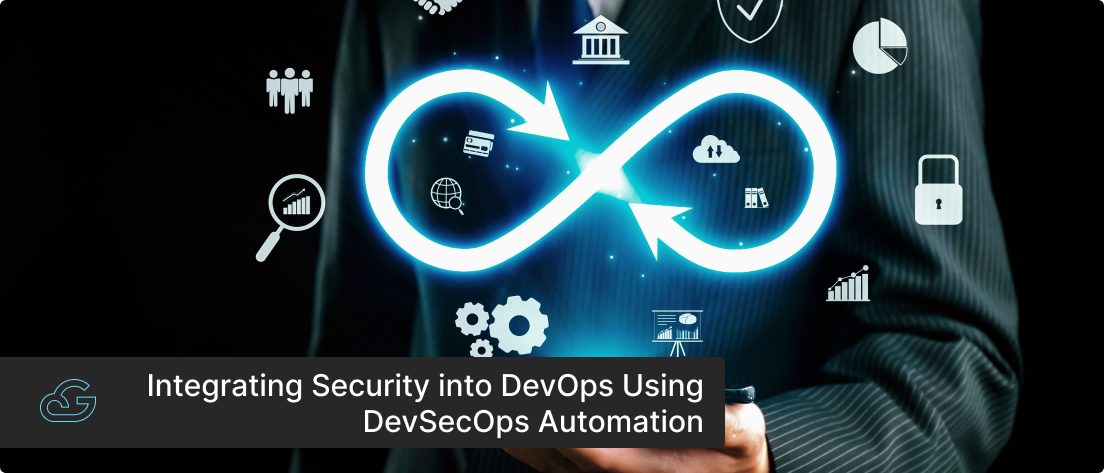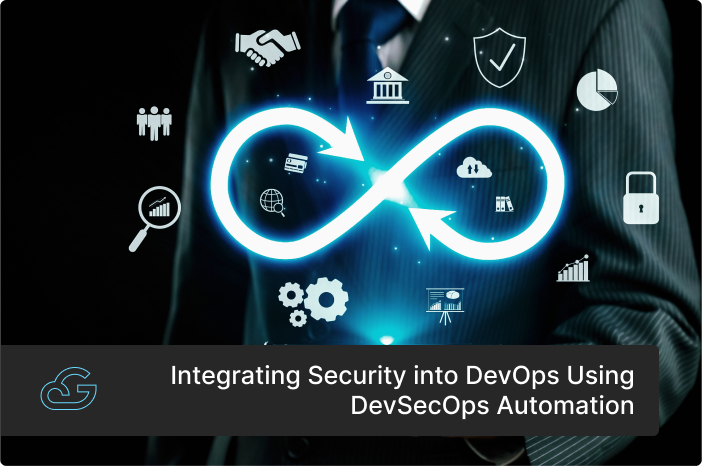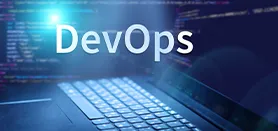Blogs / DevOps and Automation
Integrating Security into DevOps Using DevSecOps Automation
By
Harish K K
Posted: August 29th, 2024
• 7 minutes
“Build software safer and sooner” - this is the mantra of modern businesses aiming to create secure and efficient applications, and this practice is embodied in DevSecOps. With this practice, building secure apps is no longer a trade-off between speed and quality.
DevSecOps integrates security throughout the entire software development lifecycle, from initial planning to deployment and ongoing maintenance. This approach minimizes the risk of releasing vulnerable code, enhances collaboration among development, security, and operations teams, and accelerates the delivery of applications.
A key enabler of DevSecOps is Automation, which involves integrating automated security checks and practices in the DevOps workflow. This article helps you understand how your organization can extend certain security tools, policies, and procedures to automate security in each phase of the DevOps process.
What is DevSecOps Automation
DevSecOps automation is the practice of integrating automated security measures and processes into the DevOps workflow. It involves using tools and technologies to perform security tasks automatically. It aims to continuously integrate security and compliance throughout the entire software development lifecycle by combining the efforts of the Development (Dev), Security (Sec), and Operations (Ops) teams. This helps you build and release apps quickly without compromising their security aspects.
Key Processes Involved in DevSecOps Automation
In DevSecOps, security integration is a continuous and automated process. These processes allow businesses to deliver secure, high-quality software aligned with the requirements of modern application development practices. The key processes involved in security automation are:
-
Automated Security Testing:
Automated security testing tools continuously scan codebases and applications for vulnerabilities. These tools perform a variety of tests, including static application security testing (SAST), dynamic application security testing (DAST), and interactive application security testing (IAST). This helps developers to identify and remediate vulnerabilities early in the development lifecycle.
-
Continuous Monitoring & Threat Detection:
Continuous monitoring tools provide real-time surveillance of applications and infrastructure environments. They detect anomalies, potential security threats, and unusual activities that could indicate a security breach.
-
Infrastructure as Code (IaC) Security:
Infrastructure as Code (IaC) involves managing and provisioning computing infrastructure through machine-readable definition files, rather than physical hardware configuration or interactive configuration tools. IaC security ensures that these definitions include secure configurations and practices.
-
Automated Compliance Checks:
Automated compliance checks involve using tools that continuously verify that software and infrastructure configurations adhere to industry standards, regulatory requirements, and internal security policies. These checks can be integrated into the CI/CD pipeline.
-
Incident Response Automation:
Incident response automation streamlines the process of identifying, analyzing, and responding to security incidents, enabling quick and effective mitigation. This involves using advanced algorithms, machine learning, tools such as Security Information and Event Management (SIEM) systems, and Security Orchestration, Automation, and Response (SOAR) platforms to detect security incidents in real time.
Whether you're a developer, a security professional, or an IT manager, understanding the methodologies for incorporating DevSecOps automation into your DevOps workflow is important. Let's learn them in detail.
How to Integrate DevSecOps Automation into Your DevOps Pipeline?
DevSecOps Automation is not a one-size-fits-all solution. Instead, the process involves methodologies that establish a culture of collaboration and strategically select the right automation tools at each phase of the DevOps pipeline.
-
Planning:
Gsoft’s DevSecOps practices begin with collaborative discussions, review, planning strategies for security analysis, and creating a schedule for security testing specific to where, when, and how it will be carried out.
DevSecOps Methodology
- Identify and assess potential threats and risks, such as data breaches or leakages.
- Incorporate security plugins into Integrated Development Environments (IDEs) to provide developers with real-time feedback on security issues as they code.
- Develop metrics to measure the effectiveness of security practices and ensure continuous improvement.
- Implement threat modeling to identify and mitigate potential security threats during the design phase of software development.
- Evaluate security policies and local and global compliance requirements.
-
Coding:
This phase involves developing secure codebases and creating plans to address components that present security risks. We also foster a culture of defensive programming utilizing policies that help our customers proactively navigate security and compliance issues. Each commit/merge automatically triggers security testing and review with the help of security tools integrated into the development workflow.
DevSecOps Methodology
- Set Secure coding standards and best practices that emphasize security considerations, such as input validation, output encoding, and proper error handling.
- Conducting peer code reviews to identify security vulnerabilities, architectural flaws, and adherence to coding standards.
- Static Code Analysis coding errors, and compliance violations.
- Security units and functional tests to validate the security controls and functionality of the code.
- Pre-commit hooks to enforce security checks and policies before code is committed to the version control system.
- Configure CI/CD pipelines with security controls and gates to ensure that only secure and compliant code is deployed to production.
- Managing dependencies and third-party libraries to mitigate security risks associated with outdated or vulnerable components.
Tools Examples Source Code Quality PMD, SpotBugs, CheckStyle Code Review Phabricator, Gerrit -
Build & Test:
The build and test phase includes automated security analysis of the build artifacts. Dependency checks are carried out on external code which may come from unreliable or unidentified sources to identify security flaws and vulnerabilities. Static and dynamic application security testing enables the detection of application flaws within user authentication, authorization, and API endpoints.
DevSecOps Methodology
- Dynamic Application Security Testing (DAST) to conduct strong security testing of running applications to identify vulnerabilities in real-time.
- Static Application Security Testing (SAST) to analyze the application's source code or compiled binaries to identify security vulnerabilities, coding errors, and potential weaknesses in the software.
- Software Component Analysis to scan third-party dependencies and libraries used in the application for known vulnerabilities and security issues.
- Reviewing and validating cloud infrastructure configurations to ensure compliance with security best practices and policies.
- Penetration testing that simulates attacks on the application and infrastructure to identify potential security weaknesses and vulnerabilities.
- Perform Interactive Application Security Testing (IAST) during application runtime to identify vulnerabilities in real-time.
- Scanning the application and infrastructure including servers, networks, and cloud environments for security misconfigurations and proactive identification.
-
Release:
This phase focuses on protecting the runtime environment architecture by reviewing environment configuration values, including network firewall access, user access control, and personal data management. Implementing the Principle of Least Privilege (POLP) restricts each user or tool's access strictly to what is necessary for their specific needs.
DevSecOps Methodology
- Control access tokens and API keys to ensure only authorized entities can access sensitive resources.
- Conduct regular audits of access control mechanisms to ensure compliance with security policies and identify any unauthorized access or permissions issues.
- Implement configuration management solutions to automate the deployment and management of infrastructure and application configurations.
- Regularly review and audit system configurations to identify and remediate security weaknesses.
- Ensure compliance with regulatory requirements and industry standards, such as GDPR, HIPAA, PCI DSS, and so on.
- Conduct threat modeling exercises to identify potential security threats and vulnerabilities in the runtime environment architecture.
- Perform live site penetration testing to assess the security posture of the production environment.
-
Deployment:
In the Deployment phase of DevSecOps integration, the primary concern is to address security issues that may affect live production systems. It is important to identify configuration changes between the production environment and the staging or development environment to prevent any unintended security consequences. Applying chaos engineering principles helps check resilience to turbulence, simulating real-world scenarios like network connectivity loss, disk/server crashes, and so on.
DevSecOps Methodology
- Implement comprehensive logging mechanisms to capture detailed information about system operations, user activities, and security events.
- Security smoke test to ensure that critical security controls and configurations are correctly implemented.
- Threat analytics that involves monitoring security logs, network traffic, and user behaviors to identify potential security incidents and anomalies.
- Chaos testing to test the system's resilience to unexpected disruptions.
- Ensure that Transport Layer Security (TLS) certificates and Digital Rights Management (DRM) certificates are correctly configured and valid.
-
Operate and Monitor:
Once deployed in a live production environment, the system is continuously monitored. Automated security checks and monitoring loops help identify abnormalities and prevent cyber attacks and leaks. When an incident occurs, the built-in logging and instrumentation help pinpoint the issue and its impact.
DevSecOps Methodology
- Continuous Monitoring of the system's operations and security posture.
- Implementing IaC tools to automate managing and provisioning of computing infrastructure through machine-readable scripts.
- Threat Intelligence to gather and analyze information about current and emerging threats.
- Penetration Testing to identify security weaknesses by simulating attacks on the system.
- Event Management to detect and manage incidents that occur within the IT infrastructure.
- Patching involves regularly updating software to fix security vulnerabilities and improve functionality.
Which Industries Can Make the Best Use of DevSecOps?
Whether in government, education technology, telecommunications, or manufacturing, adopting DevSecOps is essential for maintaining trust, safeguarding assets, upholding regulatory compliance standards, and delivering secure and resilient solutions to customers. Let's explore why implementing DevSecOps is vital for businesses across diverse industries.
-
Government and Defense:
DevSecOps facilitates rapid and secure software deployment in government and defense sectors. For instance, a defense contractor can leverage automated security testing tools to ensure that software for military applications meets stringent security requirements and compliance standards. This accelerates the delivery of mission-critical systems while maintaining robust security protocols.
-
Education Technology (EdTech):
DevSecOps helps EdTech companies protect student data and privacy while delivering innovative educational solutions. For example, online learning platforms can implement automated security scans and compliance checks to ensure student information is encrypted, access controls are enforced, and data handling practices comply with regulations like FERPA (Family Educational Rights and Privacy Act).
-
Telecommunications:
DevSecOps supports telecommunications companies in delivering secure and reliable services to customers. With DevSecOps, a telecom provider can automate security checks for network infrastructure and software-defined networking (SDN) solutions. This ensures that network configurations are secure, vulnerabilities are patched promptly, and customer data remains protected against data breaches and network intrusions.
-
Manufacturing and Industrial IoT (IIoT):
DevSecOps enables manufacturers to enhance the security of industrial control systems and IoT devices. A manufacturer of connected industrial machinery can integrate security testing tools into the product development processes to identify and remediate vulnerabilities in firmware and software. This minimizes the risk of cyberattacks that could disrupt operations or compromise safety.
Automate Your DevOps Security Through Gsoft’s Managed Security Services
Gsoft Cloud's managed DevSecOps service promotes a cultural shift and
integrates practices and tools that combine application development, IT
operations, and security. This approach helps your organization develop
efficient and secure applications at a high velocity. DevSecOps is an
ongoing process that must be continuously iterated and applied across
development cycles to minimize security risks. Therefore, selecting and
implementing the right methodologies and tools to automate it is crucial
and necessitates expert assistance. Gsoft's top-tier managed security
services provide custom solutions that automate security throughout the
development cycle, helping you build an efficient infrastructure for your
applications.
Chat with our experts to understand how we can help you with
your security automation needs.


Get Know More About Our Services and Products
Reach to us if you have any queries on any of our products or Services.











